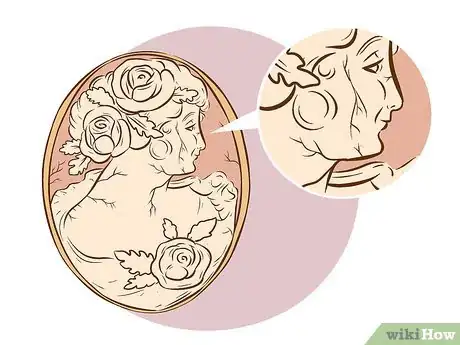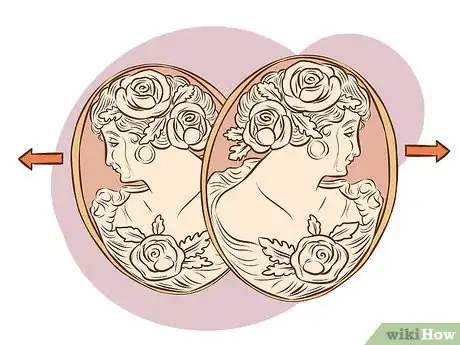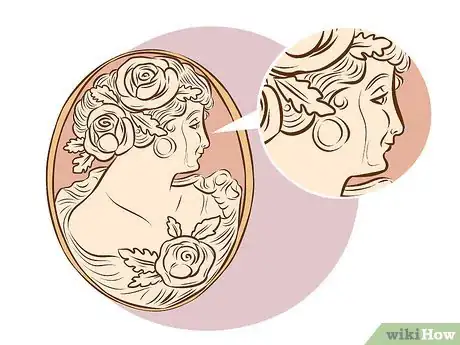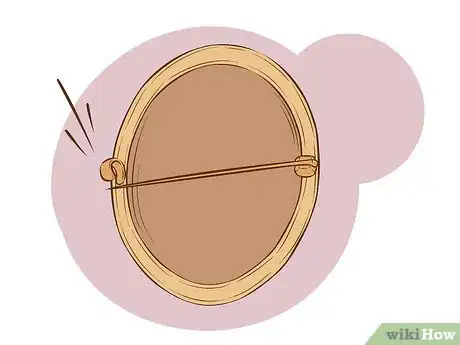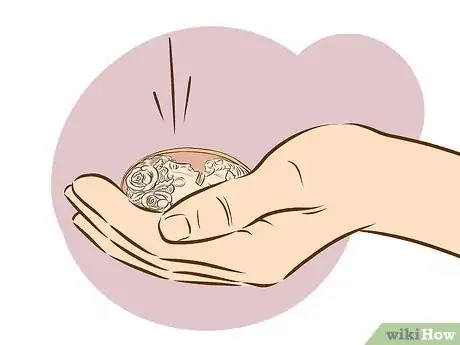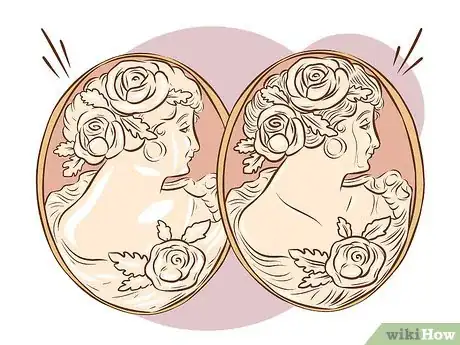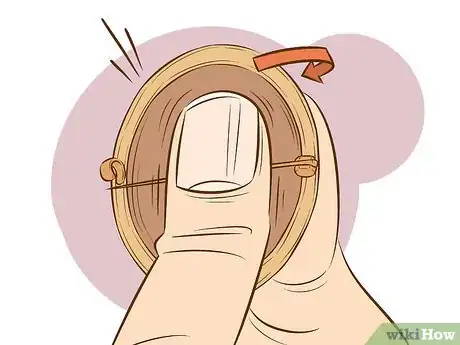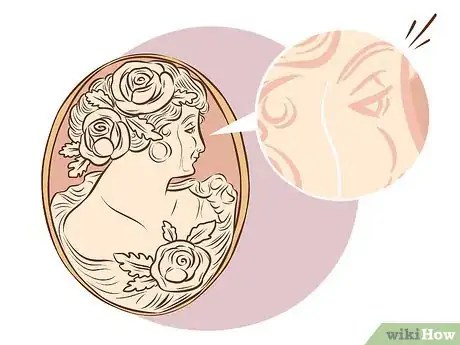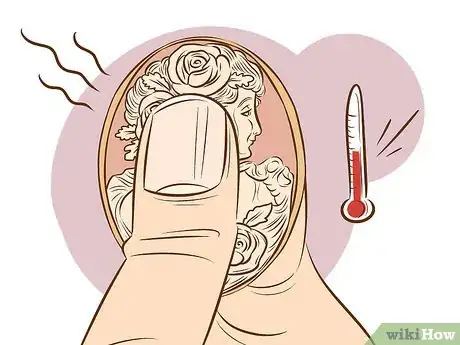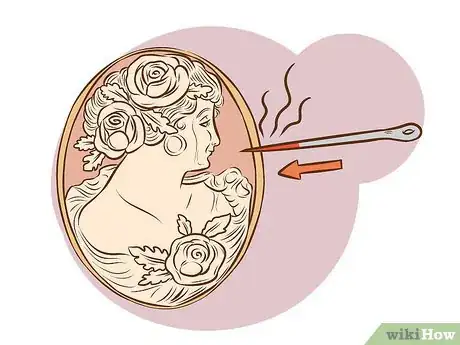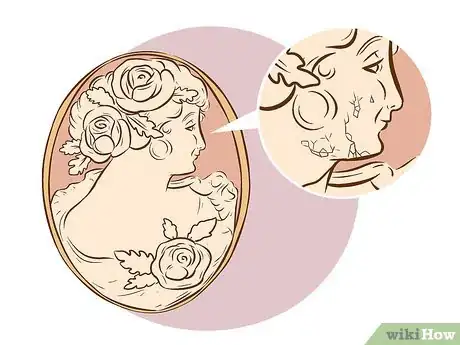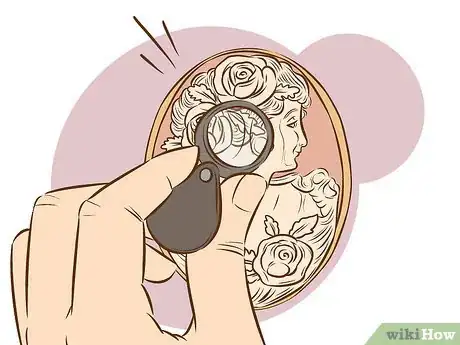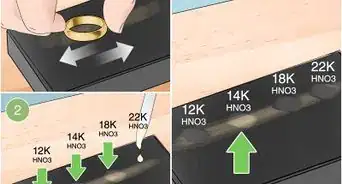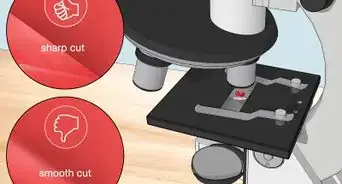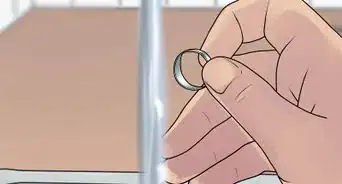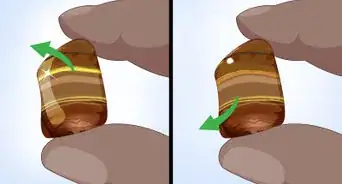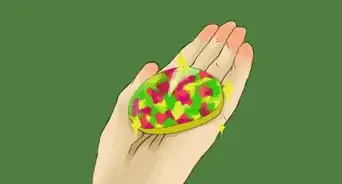wikiHow is a “wiki,” similar to Wikipedia, which means that many of our articles are co-written by multiple authors. To create this article, volunteer authors worked to edit and improve it over time.
wikiHow marks an article as reader-approved once it receives enough positive feedback. This article received 26 testimonials and 97% of readers who voted found it helpful, earning it our reader-approved status.
This article has been viewed 299,555 times.
Learn more...
The cameo is a very elegant piece of jewelry that has recently come back into fashion, but due to its popularity, there are more realistic imitations nowadays than ever before. It can be difficult to know when a cameo is an authentic antique piece or a modern day imitation, but there are a few clues to consider.
Steps
General Identification
-
1Know which materials are most authentic. Authentic carved cameos can be made of shell or natural stone, while authentic painted cameos are typically made from porcelain.[1]
- As a general rule, any carved cameo made from a natural material can be considered authentic. Some of the materials used include shell, agate, carnelian, onyx, ivory, lava, coral, jet, bone, mother of pearl, and various gemstones.
- A cameo is referred to as being non-authentic or fake if it has been made with plastic or resin.
-
2Inspect the cameo for cracks. Hold your cameo up to the light. Regardless of the material and the age, you should see no chips or cracks in the foundation material.[2]
- Soft plastics chip easier than shell, porcelain, and stone do. Hard resins are fairly chip-resistant, though.
- This speaks more to the cameo's value rather than its authenticity. A chipped cameo might be real, but these signs of damage will cause its market value to decline.
Advertisement -
3Look at the direction of the face. The majority of antique cameos will have a figure facing right. After that, a leftward facing figure is most common, followed by a forward facing figure.
- Since figures on authentic vintage cameos can face in any of these three directions, this alone is definitely not an indication of authenticity.
- If you have other reason to doubt whether or not the cameo is real, though, the fact that the figure faces left or forward instead of right, as is most common, could give you further reason for doubt.
-
4Observe the facial features. An authentic cameo will have high-quality figures on it. The natural curves of the chin and mouth should be reflected in the design, and the figure will usually have rounded cheeks.
- Portrait cameos that have a straight nose are usually from the Victorian era.
- Portraits with strong, "Roman" noses are usually dated before the 1860s.
- A nose that looks "cute" or button-like usually indicates a newer cameo created in the 21st century. If the nose is turned up and the features are flat, it could be a sign that the cameo is fairly modern and likely created with lasers, making it non-authentic.
-
5Note the type of pin. Flip the cameo over and look at the pin on its back. An antique or vintage piece will usually have a plain "c-clasp" on it.[3]
- With a "c-clasp," the brooch pin loops under a crescent shaped piece of metal. There is no roll-over fitting there to keep the end in place.
-
6Take detail into account. While some authentic cameos are plain, many valuable antique pieces will include finer details on the carving or painting. These features usually include things like earrings, pearl necklaces, loose curls, and flowers.[4]
- Note that some detail can actually indicate when a piece is fake. For instance, many laser cut imitations have a faint white band near the outer border of the piece.
- Some authentic cameos will be set in 14K or 18K gold frames. Silver and gold filled metal frames are also common. This is not always the case, however, and many have no settings at all.
- These frames may also be further decorated with valuable stones, but this, too, is not always true.
-
7Weigh the cameo in your hand. Plastic and glass cameos tend to be set in heavy base metals. As a result, they are usually heavier than shell and porcelain cameos.
- This is not always true, however, so weight alone is not a good indication of authenticity.
- Many stone cameos are naturally heavier than their shell and porcelain counterparts, as well.
Carved Cameo Qualities
-
1Look at the finish. Turn the cameo in your hand and observe the way the light hits it. A real shell cameo should have a matte appearance rather than a glossy one.
- This is true of most carved cameos, in fact, since many natural materials are difficult to buff after being carved.
- Some authentic stone cameos might be slightly shiny, however, so this is not a foolproof test.
-
2Inspect the back. Hold the cameo face down and brush the back with your index finger. If the cameo is made from real shell, you should feel a slight concave or curve.
- Shells have a naturally curved surface, so a cameo carved from a shell will usually have this curve, as well. The curve might be slight, though.
- This does not necessarily apply to natural carved cameos made from stones or other materials, though.
-
3View the cameo in strong light. With the back of the piece facing you, hold the cameo up against the sunlight on a particularly bright day or up against a strong artificial light. You should be able to see the entire silhouette if your cameo is made from shell.
- Note that this is not true of most stone cameos.
- While somewhat rare, some plastic cameos are similarly thin and may show the silhouette, as well. As a result, this is not a foolproof test when done on its own.
-
4Use a strong magnifying glass to look for marks. Inspect the front of the cameo with a very strong magnifying glass or jeweler's loupe. You should be able to see faint marks made by the carving tool around the carved portions of the piece.
- This is true for all naturally carved cameos.
- Carve marks will usually follow the lines and curves of the design. Scratches that do not appear to follow these lines are usually just scratches and should not be perceived as an indication of authenticity.
-
5Feel the temperature. Hold the cameo in your hand for 30 seconds or so. A real stone or shell cameo will feel fairly cool, but a plastic piece will quickly warm up due to the temperature of the room and the heat of your skin.
- You could also hold the cameo to your wrist or chin. These areas are generally a little cooler than the palm of your hand and may give you a more accurate indication.
-
6Test the hardness. Gently hit the cameo against your tooth and listen for the sound it produces. If it sounds dull or hollow, it is likely made from plastic.
- In contrast, a cameo that sounds fairly solid is likely made of stone or another natural material.
- Be careful when performing this test. Do not strike the piece against your teeth too hard since doing so could damage your tooth or the cameo.
-
7Poke the cameo with a hot needle. Heat a sewing needle over a small flame or under running water, then poke the needle into the cameo. It will easily melt soft plastic but should not damage shell or stone.
- Note that many modern resins are too hard and will not be melted that easily, though, so the test may not work.
- Work carefully to prevent an accidental burn while handling the hot needle. Wear heat-proof gloves or hold the needle with plastic tweezers.
Painted Cameo Qualities
-
1Examine the cameo for surface paint or enamel chips. Examine the paint or enamel on the decorated front surface of the piece. The number deep scratches and chips should be few, if any.
- The quality of paint and enamel used by vintage artisans is usually more durable than that used by counterfeit manufacturers nowadays. Real cameos were made to last, so the design should be fairly intact.
- This is also an indication of value. Scratched designs cause the value of the cameo to decrease.
-
2Ask yourself how new it looks. Even though the damage to the cameo should be minimal, an authentic piece will not look new. Expect to see faded colors, a few light scratches in the paint, and other signs of wear.
- As a general rule of thumb, if the painting and the piece itself looks sparkling new, it probably is.
-
3Check the cameo under magnification. Use a magnifying glass or jeweler's loupe to examine the front and back of the piece for signs of lighter, less obvious wear.
- Even though there should be few scratches that are obvious with the naked eye, you should be able to see some faint scratches all along the surface under this sort of magnification.
Community Q&A
-
QuestionDoes the number 925 mean anything on a cameo?
 Community AnswerThe number 925 means it contains sterling silver.
Community AnswerThe number 925 means it contains sterling silver. -
QuestionWhere can you get antique cameos appraised?
 Community AnswerLook for jewelry appraisers at city antique shows, especially those who carry cameos for sale.
Community AnswerLook for jewelry appraisers at city antique shows, especially those who carry cameos for sale. -
QuestionMy cameo is at least 125 to 150 yrs old. How do I know if the material is conch or ivory?
 Community AnswerIf it is ivory, it will have become yellow by now; the darker the colour, the older the ivory (be careful some people purposefully colour it). You can also burn a needle till it is red/white hot and poke it -- if it is genuine there will be no mark.
Community AnswerIf it is ivory, it will have become yellow by now; the darker the colour, the older the ivory (be careful some people purposefully colour it). You can also burn a needle till it is red/white hot and poke it -- if it is genuine there will be no mark.
Things You'll Need
- Strong magnifying glass or jeweler's loupe
- Needle
- Flame or hot water
- Heat-proof gloves or plastic tweezers
References
About This Article
To tell if a cameo is authentic, try looking at the direction of the face. The majority of authentic antique cameos will have a figure that faces to the right. Cameos with leftward or forward facing figures do exist, but they are less common. In addition to the direction of the face, look at the facial features for high-quality designs that feature the natural curves of the chin and mouth. For example, antique portrait cameos that have a straight and long nose are usually from the Victorian era and are authentic antiques. Additional features that indicate that the cameo may be authentic include details like earrings, pearl necklaces, loose curls, and flowers in the design. For tips about how to look at the finish of the cameo, keep reading!

